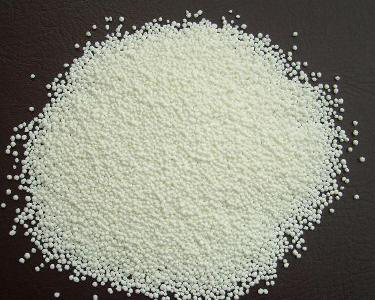Application of Sorbic acid
Background
Sorbic acid, also known as herbal tea acid, 2,4-hexadienoic acid, 2-propenyl acrylic acid, with molecular formula C6H8O2, is a food additive that has inhibitory effects on many fungi such as yeast and mold[1]. It is also used in animal feed, cosmetics, pharmaceuticals, packaging materials and rubber additives. Sorbic acid is slightly soluble in water, soluble in propylene glycol, absolute ethanol and methanol, glacial acetic acid, acetone, benzene, carbon tetrachloride, cyclohexane, dioxane, glycerol, isopropanol, isopropyl ether, methyl acetate ester, toluene.

Picture 1 Sorbic acid powdes
Properties
Sorbic acid does not decompose at room temperature and pressure, avoiding contact with strong oxides[2]. This product is low toxicity. Oral LD50 of rats is 8000 mg/kg. The equipment should be airtight, and operators should wear masks and rubber gloves. Sorbic acid exists in oriental tobacco leaves and smoke. Sorbic acid is present in trace amounts in unripe sorbic juice.
The synthetic method of sorbic acid
The ketene method is the most commonly used method for industrial production in the world. Acetic acid is cracked at high temperature to generate ketene, and then condensed with crotonaldehyde to form polyester, and then hydrolyzed and refined to obtain the finished product. Raw material consumption quota: ketene 510kg/t, crotonaldehyde 1100kg/t. Sorbic acid can also be prepared by the malonic acid method, which is mainly obtained by the condensation and decarboxylation of malonic acid and crotonaldehyde. Sorbic acid can also be prepared by the acetone method, which is mainly obtained by the condensation of acetone and crotonaldehyde, followed by dehydrogenation.
When the butadiene method uses butadiene and acetic acid as raw materials, in the presence of manganese acetate catalyst, it is subjected to compression and compression at 140°C to obtain γ-ethylene-γ-butyrolactone. Under the action of acid ion exchange resin, butyrolactone is ring-opened to obtain sorbic acid. Acetic acid is cracked at high temperature to generate ketene, which is then condensed with crotonaldehyde to form polyester, and then hydrolyzed and refined to obtain the finished sorbitol. At 0ºC, crotonaldehyde and ketene are reacted under the catalysis of boron trifluoride, or sorbic acid is prepared by heating from 2-butenal and malonic acid in the presence of pyridine.
Application of sorbic acid
sorbic acid is widely used in food, beverage, pickles, tobacco, medicine, cosmetics, agricultural products and other industries. It is also used in preservatives, antifungal agents, insecticide formulations and synthetic rubber industries. Mold and yeast inhibitor. Food mildew inhibitor. Drying oil denaturant. fungicide.
Sorbic acid and potassium sorbate are the most widely used preservatives in the world. They have high antibacterial properties and inhibit the growth and reproduction of molds. Molds, yeasts, and many aerobic bacteria have inhibitory effects, but are almost ineffective against anaerobic spore-forming bacteria and Lactobacillus acidophilus. Widely used in cheese, yogurt and other cheese products, bread and snack products, beverages, fruit juices, jams, pickles and fish products and other food preservation. The amount of concentrated fruit and vegetable juice in plastic barrels shall not exceed 2g/kg; the maximum amount used in soy sauce, vinegar, jams, hydrogenated vegetable oil, soft candy, dried fish products, instant bean products, pastry fillings, bread, cakes and moon cakes is 1.0 g/kg; maximum usage in wine and fruit wine 0.8g/kg; maximum usage in collagen casings, low-salt pickles, sauces, preserves, juice (flavored) beverages and jelly; maximum usage in fruits and vegetables The maximum amount used in fresh-keeping and carbonated beverages is 0.2g/kg; in the food industry, it can be used in meat, fish, eggs, and poultry products with a maximum amount of 0.075g/kg. In addition, sorbitol can also be used in many aspects such as washing products, cosmetics, feed, medicine and so on.
Storage of sorbic acid
sorbic acid is suitable for storage in a cool, ventilated warehouse. Keep away from fire and heat sources. Keep container tightly closed. should be kept away from oxidizer, do not store together. Prohibit the use of mechanical equipment and tools that are prone to sparks. Storage areas should be equipped with emergency release equipment and suitable containment materials. sorbic acid is generally packaged in plastic bags and plastic linings, outer woven bags or paper drums. The net weight is about 1kg-5kg. Pay attention to moisture and sun protection, do not contact with other chemicals, and store and transport according to the regulations of first-class chemicals.
Reference
1 Gao Hejuan, Yang Zuying, Wei Runyun, etc. Determination of sorbic acid and benzoic acid in food. 1982
2 Deng Ming, Ha Yiming, Yan Fengwei, Wu Moucheng. Interaction analysis of NISIN, EDTA and potassium sorbate in the storage and preservation of chilled meat. 2005
Related articles And Qustion
See also
Lastest Price from Sorbic acid manufacturers

US $1200.00-1100.00/ton2025-08-06
- CAS:
- 110-44-1
- Min. Order:
- 1ton
- Purity:
- 99%
- Supply Ability:
- 1000T/M

US $10.00/KG2025-04-21
- CAS:
- 110-44-1
- Min. Order:
- 1KG
- Purity:
- 99%
- Supply Ability:
- 10 mt



